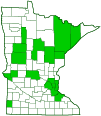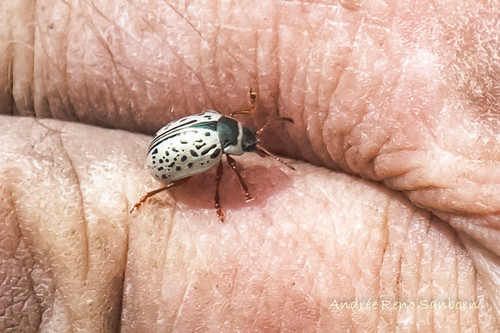common willow calligrapher beetle
(Calligrapha multipunctata)
Conservation • Description • Habitat • Ecology • Distribution • Taxonomy
|
|
|||||||||||||
Description |
Common willow calligrapher beetle, also called common willow calligrapher beetle, is a small, broad-bodied leaf beetle. It occurs throughout the United States and southern Canada. It is common in Minnesota. Adults are active from April to September. Most calligrapher beetles are specialist feeders, feeding on a single species or a small group of species. The preferred host for common willow calligrapher beetle is Bebb’s willow (Salix bebbiana). Adults are ¼″ to 5⁄16″ (6.5 to 8.5 mm) in length. The body is elongated-oval when viewed from above and very convex when viewed from the side. The head, exoskeletal plate covering the first segment of the thorax (pronotum), and dark markings on the hardened wing covers (elytra) are black without a metallic green sheen. The head is inserted into the first segment of the thorax and is only partly visible from above. The mouthparts are directed downward. The antennae are black and have 11 segments. They are weakly expanded beyond the fifth segment, gradually enlarged as they approach the tip. The eyes are not notched. The pronotum is rectangular and wider than the head. It is dark reddish brown with a broad pale band around the front and lateral margins and a black spot of variable size in the middle. The black spot is usually very large, completely or almost completely obscuring the reddish-brown area. The sides of the thorax are not thickened. The elytra are creamy white. Each elytron has three longitudinal lines, a large, boot-shaped spot near the base in the shoulder area, and numerous small spots. The spots are all black. The markings are variable, and they have been named as an aid to identification of the species in this genus. The stripes include: a complete stripe on the inner margin (sutural stripe); a complete stripe near the inner margin (subsutural stripe); and a short, curved stripe (arcuate stripe). The three stripes are clearly separated from each other. The subsutural stripe and usually the sutural stripe is as dark as the other markings. The arcuate stripe is sometimes interrupted, sometimes partly broken into small spots. The lateral margins are completely pale and free of dark spots. The legs are dark reddish brown. The last part of each leg (tarsus), corresponding to the foot, has five segments. The fourth segment is very short and is concealed within the broadened tip of the third segment, making the tarsus appear to have only four segments. There is a pair of claws at the tip of the tarsus on each leg. The claws are well separated at the base. _______________________ The above description refers to Calligrapha multipunctata multipunctata. |
Size |
Total length: ¼″ to 5⁄16″ (6.5 to 8.5 mm) |
Similar Species |
Dogwood calligrapha (Calligrapha philadelphica) dark markings have a metallic green sheen. The pronotum is entirely dark. |
Habitat |
|
Ecology |
Season |
May to September |
Behavior |
|
Life Cycle |
|
Larva Food |
|
Adult Food |
Bebb’s willow (Salix bebbiana) |
Distribution |
||
|
Sources Biodiversity occurrence data published by: Minnesota Biodiversity Atlas (accessed through the Minnesota Biodiversity Atlas Portal, bellatlas.umn.edu, 6/18/2025). |
|
| 6/18/2025 | ||
Occurrence |
||
|
||
Taxonomy |
|
Order |
Coleoptera (Beetles) |
Suborder |
Polyphaga (Water, Rove, Scarab, Long-horned, Leaf, and Snout Beetles) |
Infraorder |
Cucujiformia |
Superfamily |
Chrysomeloidea (leaf beetles and allies) |
Family |
Chrysomelidae (leaf beetles) |
Subfamily |
Chrysomelinae (broad-bodied leaf beetles) |
Tribe |
Doryphorini |
Subtribe |
Doryphorina |
Genus |
Calligrapha (calligrapher beetles) |
Subgenus |
Calligrapha |
Subordinate Taxa |
|
common willow calligrapher beetle (Calligrapha multipunctata bigsbyana) common willow calligrapher beetle (Calligrapha multipunctata multipunctata) |
|
Synonyms |
|
|
|
Common Names |
|
common willow calligrapha common willow calligrapher common willow calligrapher beetle spotted calligraphy leaf beetle |
|
Glossary
Elytra
The hardened or leathery forewings of beetles used to protect the fragile hindwings, which are used for flying. Singular: elytron.
Epipleuron
On beetles: The prominent, turned down or turned under, lateral edge of an elytron. Plural: epipleura.
Pronotum
The exoskeletal plate on the upper side of the first segment of the thorax of an insect.
Tarsus
On insects, the last two to five subdivisions of the leg, attached to the tibia; the foot. On spiders, the last segment of the leg. Plural: tarsi.
Visitor Photos |
||
Share your photo of this insect. |
||
This button not working for you? |
||
Sarah Stenger |
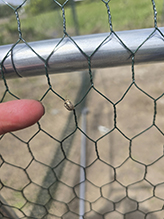 |
MinnesotaSeasons.com Photos |
||
Common willow calligrapher beetle on willow |
||
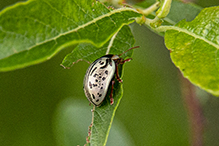 |
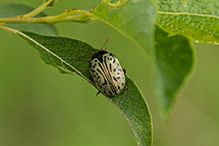 |
|
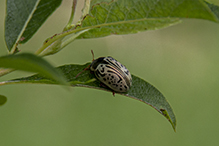 |
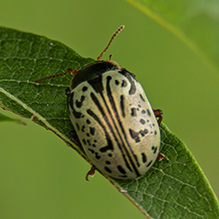 |
|

Visitor Videos |
||
Share your video of this insect. |
||
This button not working for you? |
||
|
Other Videos |
||
|

Created: 1/2/2024 Last Updated: © MinnesotaSeasons.com. All rights reserved. |
